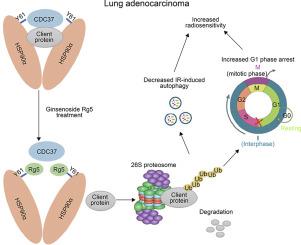Journal of Pharmaceutical Analysis ( IF 6.1 ) Pub Date : 2023-06-07 , DOI: 10.1016/j.jpha.2023.06.004 Hansong Bai 1 , Jiahua Lyu 1, 2 , Xinyu Nie 3 , Hao Kuang 1 , Long Liang 1 , Hongyuan Jia 1 , Shijie Zhou 4 , Churong Li 1 , Tao Li 1, 2

|
Ginsenoside Rg5 is a rare ginsenoside showing promising tumor-suppressive effects. This study aimed to explore its radio-sensitizing effects and the underlying mechanisms. Human lung adenocarcinoma cell lines A549 and Calu-3 were used for in vitro and in vivo analysis. Bioinformatic molecular docking prediction and following validation by surface plasmon resonance (SPR) technology, cellular thermal shift assay (CETSA), and isothermal titration calorimetry (ITC) were conducted to explore the binding between ginsenoside Rg5 and 90 kD heat shock protein alpha (HSP90α). The effects of ginsenoside Rg5 on HSP90-cell division cycle 37 (CDC37) interaction, the client protein stability, and the downstream regulations were further explored. Results showed that ginsenoside Rg5 could induce cell-cycle arrest at the G1 phase and enhance irradiation-induced cell apoptosis. It could bind to HSP90α with a high affinity, but the affinity was drastically decreased by HSP90α Y61A mutation. Co-immunoprecipitation (Co-IP) and ITC assays confirmed that ginsenoside Rg5 disrupts the HSP90-CDC37 interaction in a dose-dependent manner. It reduced irradiation-induced upregulation of the HSP90-CDC37 client proteins, including SRC, CDK4, RAF1, and ULK1 in A549 cell-derived xenograft (CDX) tumors. Ginsenoside Rg5 or MRT67307 (an IKKε/TBK1 inhibitor) pretreatment suppressed irradiation-induced elevation of the LC3-II/β ratio and restored irradiation-induced downregulation of p62 expression. In A549 CDX tumors, ginsenoside Rg5 treatment suppressed LC3 expression and enhanced irradiation-induced DNA damage. In conclusion, ginsenoside Rg5 may be a potential radiosensitizer for lung adenocarcinoma. It interacts with HSP90α and reduces the binding between HSP90 and CDC37, thereby increasing the ubiquitin-mediated proteasomal degradation of the HSP90-CDC37 client proteins.
中文翻译:

人参皂苷 Rg5 通过减少 HSP90-CDC37 相互作用并促进客户蛋白降解来增强肺腺癌的放射敏感性
人参皂苷 Rg5 是一种罕见的人参皂苷,具有良好的肿瘤抑制作用。本研究旨在探讨其放射增敏作用及其潜在机制。人肺腺癌细胞系 A549 和 Calu-3 用于体外和体内分析。通过生物信息学分子对接预测,并通过表面等离子共振(SPR)技术、细胞热位移测定(CETSA)和等温滴定量热法(ITC)进行验证,以探索人参皂苷Rg5与90 kD热休克蛋白α(HSP90α)之间的结合。进一步探讨了人参皂苷 Rg5 对 HSP90-细胞分裂周期 37 (CDC37) 相互作用、客户蛋白稳定性和下游调控的影响。结果表明,人参皂苷 Rg5 可以诱导细胞周期阻滞在 G1 期,并增强辐射诱导的细胞凋亡。它能够以高亲和力与HSP90α结合,但由于HSP90α Y61A突变,亲和力急剧下降。免疫共沉淀 (Co-IP) 和 ITC 测定证实,人参皂苷 Rg5 以剂量依赖性方式破坏 HSP90-CDC37 相互作用。它减少了 A549 细胞来源的异种移植 (CDX) 肿瘤中辐射诱导的 HSP90-CDC37 客户蛋白的上调,包括 SRC、CDK4、RAF1 和 ULK1。人参皂苷 Rg5 或 MRT67307(一种 IKKε/TBK1 抑制剂)预处理可抑制辐射诱导的 LC3-II/β 比率升高,并恢复辐射诱导的 p62 表达下调。在 A549 CDX 肿瘤中,人参皂苷 Rg5 治疗可抑制 LC3 表达并增强辐射诱导的 DNA 损伤。总之,人参皂苷Rg5可能是肺腺癌潜在的放射增敏剂。 它与 HSP90α 相互作用,减少 HSP90 和 CDC37 之间的结合,从而增加泛素介导的 HSP90-CDC37 客户蛋白的蛋白酶体降解。


















































 京公网安备 11010802027423号
京公网安备 11010802027423号